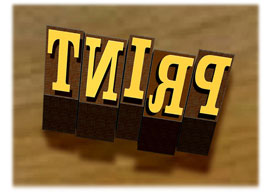Once the writing, design and artwork is complete, you may require your work to be printed, (i.e. your leaflets, posters, direct mail, magazine inserts, stationery etc.) and it can be a bit of a minefield as there's plenty that can go wrong (and can also be quite time-consuming) so it's well worth having a basic understanding of the principles and pitfalls...
PRINT SYSTEMS. There are a few basic print systems available and a myriad of different machines used by thousands of different print companies and getting your job on the right machine with the right company will greatly affect the quality, the cost and the timing.
PRINT ESTIMATES. You can only obtain an accurate estimate for a print job if firstly, you've asked the right company (see above) but secondly that you've asked all the right and all-important questions and provided the printer with all the correct and relevant information.
PRINT RUNS, RUN-ONS & REPRINTS. Surprisingly, there are many people who mistake
'run-ons' and 'reprints'. A run-on is simply the the extra cost for extra printing 'at the same time' as the main run,
whereas a reprint is exactly what the word implies - a new print job using the existing material. As an example, a 5,000 run may cost £700 + £70 per '000
run-on, therefore 10,000 will cost £1,050.
Yet a 5,000 reprint could cost another £650, therefore the 10,000 in
2 separate print runs has cost £1,350, so getting the print run figure right is paramount.
EXTRA COSTS. If the print quote 'brief' wasn't fully detailed, there may well be further charges which could come as a surprise, such as proofing, sealing, finishing, despatch and (with some clients) even the VAT.
ARTWORK FORMAT. Whilst you've seen the work bouncing back and forth, probably as a lo-res PDF, once finalized the artwork needs to be formatted specifically for the printer, in the correct application (Photoshop, Quark, PDF) to the correct resolution, in the correct colour mode (CMYK, RGB), inclusive of trims & fold marks and usually supplied with a digi-proof and, if necessary, a mock-up.
PRINT STOCK. The material (paper) and there are thousands to choose from; matt, silk, gloss, different 'weights' (known as 'gsm' - grams per square metre) and choosing the correct stock can make a huge difference to both quality and cost.

SCHEDULING. Once you've approved the artwork, you've started a chain reaction that needs a tight schedule (to the day, sometimes to the hour) from the purchase of the stock, to the repro and plates, and you've booked machine time (on possibly a £1m Heidelberg jobbie) and also perhaps with a finishing company. If you suddenly want to move any goalposts it could prove very costly.
PRINT APPROVAL. Remember, to ensure that everything goes to plan there are certain disciplines required. You must make sure that the printer was thoroughly briefed. You must make sure that the artwork is final and approved, make sure you have approved the stock, make sure you have either signed off a printer's proof OR actually checked the work 'on press' at the time of printing. If you've done all that, and you're with a good printer, nothing should go wrong.
WHAT CAN GO WRONG? Quite a lot, unless you have worked to all the basic principles detailed above.